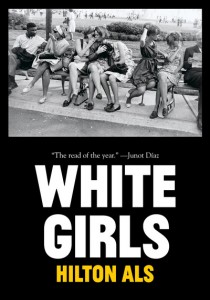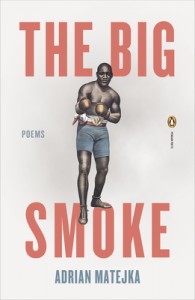White Girls by Hilton Als
 White Girls
White Girls
by Hilton Als
McSweeney’s, Nov 2013
344 pages / $24 Buy from McSweeney’s or Amazon
White Girls ends with the essay “It Will Soon Be Here,” a meditative consideration of memory and the flexibility of first person. The essay could prefigure the entire collection by Hilton Als: “For as long as my memory can remember, I existed characterless, within no memory at all. Or if I did exist it was in remembering the text of someone else’s life—that is in the devouring of biography.” That which is devoured must soon be released, and Als does so in White Girls, covering Truman Capote, Eminem, Richard Pryor, Malcolm X, André Leon Talley, James Baldwin, Flannery O’Connor, and Als himself. Early critical mentions of this book as controversial not only miss the point (idiom Als uses effectively on many occasions regarding the misunderstanding of other persons and writers), but fail to recognize that Als has been building toward this book since The Women (1998). White Girls is pure performance, a writer in absolute control.
In “A Pryor Love,” Als’s wide-ranging essay on the comedian, he notes that “unlike Lenny Bruce, [Pryor] didn’t believe that if you said a word over and over again it would lose its meaning.” The same could be said of “white girls,” or “white women,” which are flashed by Als like a card, a refrain, a reminder. In a scene within “The Only One,” Als’s sketch of Vogue editor Talley, a “black drag queen . . . sat on the lap of a bespectacled older white man,” and said “That’s what I want you to make me feel like, baby, a white woman.” For Als, being or becoming white is not quite an assimilation into difference, it is an act of twinning. White Girls begins with the nearly 100 page nonfiction novella, “Tristes Tropiques,” that documents Als’s complicated love for SL (“Sir or Lady”), who is first described in the midst of a daydream. It would be quite dangerous to read White Girls in full-on mimetic mode; the book starts, after all, with Als imagining SL “deep in movie love,” thinking about SL’s own thoughts, when the “movie guy kisses the movie girl and they are one.” This trope of twinning becomes an anchor for not only the relationship between Als and SL, but also the other loves of Als. Also loves SL, but they “are not lovers. It’s almost as if I dreamed him—my lovely twin, the same me, only different.” There are levels and modes of twins. Als recognizes the idea of a mirror, that other that is the self, but also the opportunity to “grow into one . . . as Aristophanes sort of has it in The Symposium.” Twinship, for both SL and Als, is the “archetype for closeness . . . [and for] difference.” Twinship is “marriage . . . joined by a ring and flesh.” It is “reflection.” The origin of this desire? “I have always been one half of a whole,” Als admits. An older brother was stillborn; “my ghostly twin, my nearly perfect other half.” His mother is his “soul’s twin.” For Als, all love is a form of self-completion, the discovery that the “I” needs a second to live.
I am the father of identical twin girls, so I breathe this world of twins. The moments of mistaken identity, the calling of incorrect names. My wife—she my twin, of sorts, us together and inseparable for a dozen years now—pass our twins (Amelia and Olivia) back and forth, their identities switching with each shifting hands. For twins, the collective is not pejorative. “I” becomes wide. Als finds this ultimate twinship in SL, for they lived parallel lives, not quite in biography but in gesture, as they “had both grown up feeling that the language we spoke was somehow incomprehensible or fuzzy to those around us.” Yet SL was not Als’s first twin love; that was Marie, a white girl who “wasn’t technically white—her mother was Puerto-Rican and her father Jewish—but she looked the part: camellia-white skin and blonde hair.” Als’s prose, in her presence, is nothing short of sensual: “She alone could charge makeup at the family drugstore. I felt so much about her. She wore ropes of white beads a Santeria had given her. In her room: flickering candles, prayers for the dead, Santeria-blessed waters. Sometimes she sprinkled the waters on me. She made my soul happen.”
Yet Als arrives at the same question about Marie that the reader asks in relation to SL: “Did I love her or want to be her? Is there a difference?” He concludes: “I wanted her more than anything; her whiteness or, more accurately, her misleading whiteness—the blonde mistaken for a gringo by Latin men; the Jewish girl mistaken for a shiksa by Jewish men; a white girl mistaken for a white girl in my colored world—felt not unlike myself and not like myself all at the same time.” Even in this first essay, Als reveals his nuance, why he demands reading. White Girls could have been, in the hands of a novice, a smirking pastiche of all things pale. Als never simplifies: “standing above me and around me I see how we are all the same, that none of us are white women or black men; rather, we’re a series of mouths, and that every mouth needs filling: with something wet or dry, like love, or unfamiliar and savory, like love.”
The first essay alone is worth the price of the book, but Als delivers elsewhere. “The Women” begins with a photograph of Truman Capote, which is more “a shadow ground through publicity, coming out the other side as something else . . . asserting this: I am a woman.” Capote’s transformation into a woman, ultimately, “prevented other women authors from being popular, admired, celebrated.” Capote “saw women as a form of language.” Als might think the same of Michael Jackson. “Michael,” his elegy for the star, begins with a memory that his “female elders” would warn him of the men who leave the Starlite Lounge in Brooklyn. “Ben” is the theme song of those “queens,” and should be listened to on loop when reading this essay. Michael “was all child—an Ariel of the ghetto—whose appeal, certainly, to the habitués of places like the Starlite, lay partly in his ability to find metaphors to speak about his difference, and theirs.” Michael’s goal is to create an anti-twin; he “was most himself when he was someone other than himself.” He—or the idea of him—was representative of a particularly fearful type of influence, an example of the “bizarre fact that queerness reads, even to some black gay men themselves, as a kind of whiteness.”
November 25th, 2013 / 12:00 pm
This Darksome Burn by Nick Ripatrazone
 This Darksome Burn
This Darksome Burn
by Nick Ripatrazone
firthFORTH, Forthcoming October 2013
66 pages / More Information
Myth: “This Darksome Burn is a fierce rendition of nature’s obstinate force. Indeed, for one man, toughness and tenacity provide no match for the unpredictable wilderness of the shadowing Siskiyou mountain or his own bereft emotional frontier.” [1]
It’s partially true: Nick Ripatrazone’s new novella begins with Luke camped out in the woods, hunted by a pack of wolves. He has to let his horse free so the wolves will follow it instead of him. When he gets home, tragedy has occurred. He traipses through wailing snow to find the man that raped his daughter, shotgun in hand. Even the cover of the book is a great volcano-like mountain, rising foreboding and dark against the night sky. The wilderness is This Darksome Burn’s setting, as billed. But the really valuable work of the novella is in the juxtaposition between Luke’s “toughness and tenacity” and something less wild: not “his own bereft emotional frontier,” exactly, but the demands of a modern world on a man who has most of his life relied on reticence and grit, virtues of a time that has gone.
It becomes clear, as the novella goes on, that Luke’s wife has died, leaving him in charge of his teenage daughter Aurea and his younger son Ford. Luke knows that he is unequipped. When his daughter is sexually assaulted, all he can think to do is nearly kill the man who has done it, then keep Aurea on house arrest indefinitely. Her concerns are more complicated:
Luke tells Aurea that she still has time. “To tell the police everything.”
“I’m not going to.”
“You protect that bastard. Do you love him?”
“I hate him.”
“Then do it.”
“I’m trying to forget about him.” Aurea closes her hand around Luke’s and looks to the porch. “Can we not do this here?”
September 23rd, 2013 / 11:05 am
The Big Smoke by Adrian Matejka
 The Big Smoke
The Big Smoke
by Adrian Matejka
Penguin Books, May 2013
128 pages / $18 Buy from Penguin or Amazon
Mixed martial arts matches often descend into tussles, yet boxing remains a splintered dance: when you are down, you are out. The stripped-down bodies of boxers moving on the lit ring-stage is ripe for literary fetish; even Joyce Carol Oates, whose God is the unsentimental moment, could not resist waxing about Mike Tyson. Although Leonard Gardner’s 1969 novel, Fat City, chronicles the emotional and physical destruction of impoverished fighters in Stockton, California, he could not resist corporeal iconography: “Padded and trussed, his face smeared with Vaseline, a rubber mouthpiece between his teeth, he stood waiting while two squat men punched and grappled in the ring.” Sinewy syntax to represent a body ready to burst.
The same mythos allows Adrian Matejka to channel Jack Johnson, the first black heavyweight champion. Matejka concedes that Johnson, in his own memoirs, was a “natural fabulist,” so fact matters less than emotion. But hasn’t it always in boxing? When Frank Bruno said he would knock Tyson onto Don King’s lap, no one believed him: except himself. The inches between boxers allow for miles of fantasy.
The same tendency toward fantasy makes many persona poems feel like projections of the poet rather than reconsiderations of the subject. Thankfully, Matejka resists pure fantasy and artifice; treatment of Jack Johnson is complicated and passionate. He appreciates his subject, much better than the analytical mode of much persona poetry, which makes the phantasmagoric act an exercise rather than an experience. From the start, his focus is on Johnson’s body: the tension between whether Johnson owns his own body enough to profit from it. It’s a smart take on the slavery that Johnson’s parents endured, and that he retains, in and out of the ring. In “Battle Royal,” the collection’s first poem, Johnson and other blacks fight for a single prize: “the last darky on his feet gets a meal.” Free enough to know what whites feared him, and to use that fright to complement his athleticism in the ring, but enslaved by a new system, where money creates identity, however tenuous.
This duality helps Matejka play on the concept of shadow boxing, with several dialogues between Johnson and his other self, one always chiding him for “Negro / caricature,” including his gold teeth. Those teeth are a light, a presence: power. From “Gold Smile”: “They call teeth dent in France, & the name / makes sense the way teeth do what they do / to bacon & shoulders & cakes. The French / word for gold is or, so when the folks in Paris / / describe my smile it sounds like what / happens when I punch a door: dents d’or.” The poem ends with Johnson’s taunt before the Tommy Burns fight: “the only reason I got gold uppers was to make / every bite of my food twice as expensive.”
August 23rd, 2013 / 11:00 am
Reliquary by Matthew Minicucci
 Reliquary
Reliquary
by Matthew Minicucci
Accents Publishing, 2013
21 pages / $5 Buy from Accents Publishing
With a 15th century Jacopo Bellini panel stretched across a nearly gilded cover, pages the color of bone, and vacillating moments of nostalgic faith and analytical skepticism, Matthew Minicucci’s debut chapbook Reliquary feels like it could have been produced by Andy Warhol’s idiosyncratic Catholicism. John Updike, in discussing the 1989 retrospective of Warhol’s work at The Museum of Modern Art, recounts Warhol’s infamous closet Catholicism, his private acts of grace, and his daily attendance at Mass before finding the “Catholic negativity” of “profound hollowness” in Warhol’s canon. Updike’s conclusion appears in his trademark parallelism: “Protestantism, when it fades, leaves behind a fuzzy idealism; Catholicism, a crystalline cynicism.”
Minicucci’s work exudes the skepticism of a mind that still finds faith and ritual beautiful. Such is the tattoo of literary Catholicism: the whispers of youth remain as scars for some, a bright complexion for others. Reliquary is focused on a class of elementary school students led through the fourteen Stations of the Cross by their teacher, Sister Theresa. Two students in particular–the narrator and his friend Chris–return within narratives replete with philosophical and theological asides. Minicucci leads the first poem with an epigraph from Horace, referencing the Promethean act of “making each of us,” the correct precedent for a collection of poems so focused on hands, on faith formation. From the first poem alone, “Jesus is Condemned to Death”: “the perfect curve of marble hands connecting / supple to supplication”; “how Jesus’ index and middle finger separate / from the thumb, point to the sky as Pilate reads”; “Caiaphas stands with his hands outstretched / fingers splayed and downward”; “Sister Theresa sets her hand on my thigh, / presses nails into flesh, pushing / my small knee to the floor.” The focus on hands and palms is to be expected in a Catholic ritualistic milieu: the receipt of the Host, the offering of peace, yet Minicucci focuses on the terrible strength of touch. He must kneel at the first Station in order “to meditate / on each prick of thorn and pull of the lash.” Sister Theresa tells him that “This is what suffering looks like . . . It’s beautiful.”
March 8th, 2013 / 12:00 pm
Melancholia (An Essay) by Kristina Marie Darling
 Melancholia (An Essay)
Melancholia (An Essay)
by Kristina Marie Darling
Ravenna Press, 2012
72 pages / $10 Buy from Ravenna Press
Parenthetically titled “An Essay,” Kristina Marie Darling’s Melancholia is a collection of prose poems, independent lines, notes, and fragments. Prose poetry and essays are not imperfect bedfellows. Samuel Johnson defined the essay form as “A loose sally of the mind: an irregular indigested piece; not a regular and orderly composition.” His definition sounds appropriate to the form’s modern originator, 16th century French writer Michel de Montaigne, whose works unfold as scattered meditations on words and concepts. Yet Johnson’s definition is also curiously apt as a description of contemporary prose poetry. Often lacking a central narrative, prose poems typically contain development of breadth rather than depth. Darling solves that problem by using the prose poem form to link imagistic snapshots that accumulate the work’s emotional content.
Yet Melancholia is difficult to classify. Its structural form is prose poetry, its conceptual mode is almost filmic, and its narrative mode owes much to the essay’s tendency to classify and define. Melancholia posits that a poet-narrator is a good choice to “select and omit”: Darling’s prose poems are more concerned with absence than presence, as white space outweighs text within the book. Such ratio is not shocking in a volume of poetry, but the prose poetic form reestablishes the physical page in poetry. When a poet reaches for the margins in her sentences, her later abbreviations become more obvious. Darling has a nice sense of the physical page, and Ravenna Press’s pocket series, at roughly 6 by 5 inches, is the right size for a typographically spare collection.
Darling’s complicated form mirrors her complicated content. Melancholia documents a fragmented relationship in a previous, possibly Victorian, era. Time is ambiguous in the collection: although the overarching narrative occurs in an epoch of cufflinks and corsages, the work references a “little-known French film, in which the heroine makes her living by keeping nightingales,” and another, equally obscure film, where “a woman refers to her beloved as a ‘strange machine.’” This confusion about time arises from the poet’s role as essayist. Darling’s core narrative is centered on a feuding, and later separated, couple, but she overlays that narrative with fragments of fact. Her reason for bending form is tied to her title: melancholy lacks the sharp edges of anger and sadness. It is a paradoxical feeling of heft and weightlessness, so a poet would be smart to mix poetry and fact as she struggles to understand pain.
January 14th, 2013 / 12:00 pm
Nick Ripatrazone brings an in-depth and very excellent close reading and analysis of William Gass’s “The Pedersen Kid” at Quarterly Conversation: “The word snow—and its variations—appears 181 times within the 79 pages of “The Pedersen Kid.” The repetition transfers snow from word to thing: snow is overwhelming and smothering, equal parts plot, character, and theme. The word appears in the second sentence, and it completes the initial thought of the story. It is a Faulknerian convention, a trope in the tradition of adventure novels. Snow is omniscient but transient, gone come spring.”
